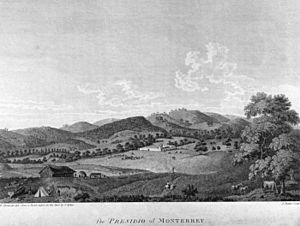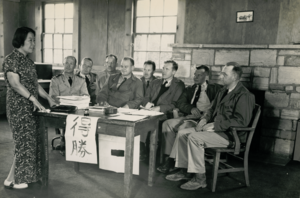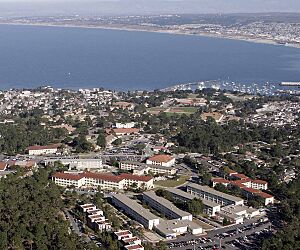Presidio of Monterey, California facts for kids
The Presidio of Monterey (often called POM) is a special place in Monterey, California. It's an active U.S. Army base with a very long history, going all the way back to when Spain ruled this area. Today, it's home to the Defense Language Institute Foreign Language Center (DLI-FLC). This is the only "presidio" (an old Spanish fort) in California that is still an active military base.
Contents
History of the Presidio
Long ago, in 1602, a Spanish explorer named Sebastián Vizcaíno visited and named Monterey Bay. He thought the natural harbor here would be a great spot for a seaport, a fort, and a new town. But it took over 150 years for Spain to decide to actually build something here. They started to worry that other European countries might try to claim the land along the Pacific Coast.
Why Spain Built a Fort Here
In 1768, a Spanish official named José de Gálvez got a very important order from the King of Spain. The order was to "Occupy and fortify San Diego and Monterey." This meant Spain wanted to build forts and settlements in these places. Gálvez quickly put together groups of people and ships to travel from Mexico to Monterey.
Spain was worried about other countries, like Britain, the Netherlands, and especially Russia, trying to take over parts of California. Gálvez even spread rumors about these threats to get the King to agree to his plans. When news came that Catherine the Great of Russia might try to build settlements down the California coast, the King gave Gálvez the green light. Spain then moved to claim and settle these areas that their explorers had only seen before.
The First Journeys to Monterey
In 1769, Gaspar de Portolá, who was the governor of California, led a group of people overland from San Diego. With him was a Franciscan friar named Junípero Serra. Later that year, Portolá led another group north from San Diego to find the port of Monterey by land. They reached Monterey Bay on October 1st.
However, they didn't realize it was the same port that Vizcaíno had described so many years before! So, they kept going north and ended up reaching San Francisco Bay. On their way back to San Diego, they placed two large crosses on the coast of Monterey. They still weren't sure if it was the right place.
In April 1770, Portolá tried again with a smaller group. This time, they arrived at Monterey Bay on May 24th. That afternoon, Portolá and Friar Juan Crespí went back to the large wooden cross they had left five months earlier. "This is the port of Monterey without the slightest doubt," Crespí wrote in his diary. They had finally found it!
Building the Spanish Fort
Once Monterey was found, a man named Miguel Costansó chose the best spot for the fort and drew the first plans. Pedro Fages was put in charge of the soldiers who would build it. He was very strict! He made his soldiers work very hard, even punishing them if they rested or tried to smoke a cigarette.
It rained a lot during the spring and winter of 1770-1771, but Fages didn't let them stop working. They had to walk through mud to chop wood and then pull their mules out of the mud. They couldn't even wash their clothes during the week. This tough work lasted for a year and a half. Finally, the soldiers complained to Friar Junípero Serra, who told Fages that he had to let the men rest on Sundays. By June 1771, the Monterey presidio was built.
The Royal Presidio of Saint Charles
The fort built by Fages was called El Presidio Real de San Carlos de Monterrey (the Royal Presidio of Saint Charles of Monterey). At the same time, Junípero Serra started a Catholic mission nearby. The original chapel of this mission is now the Cathedral of San Carlos Borromeo.
Monterey became one of several "presidios" (royal forts) that Spain built in what is now the western United States. Other forts were built in San Diego in 1769, San Francisco in 1776, and Santa Barbara in 1782.
In 1818, an Argentine privateer (like a legal pirate) named Hippolyte de Bouchard attacked the fort in Monterey. The people living there had to hide. Over the years, the Presidio of Monterey has changed a lot. It has been moved, left empty, and then used again many times. The only building left from the very first fort is the Royal Presidio Chapel. The Presidio has been under Spanish rule, then Mexican rule, and finally American rule.
Becoming a United States Fort
The United States took control of the Monterey area in 1846 during the Mexican–American War. Commodore John D. Sloat of the U.S. Navy landed his forces in Monterey without a fight and claimed the area and the Presidio for the United States. He left a small group of Marines who moved the fort to its current spot on a hill overlooking the harbor. This new location combined the military headquarters and the fort into one place. The Presidio was renamed Fort Mervine.
The original Spanish Presidio was a square of adobe buildings in what is now downtown Monterey. The original chapel has been used continuously since 1770. There's also an old earthwork (a mound of earth used for defense) on the hill overlooking the harbor. This earthwork was part of the Spanish artillery that defended the harbor.
After the U.S. took over in 1846, there was no longer a Mexican military presence at the Presidio. In 1865, near the end of the American Civil War, the fort was used again for a short time but was then left empty in 1866.
In 1902, an infantry regiment (a large group of soldiers) arrived in Monterey. Their job was to build a new base for infantry and cavalry (soldiers on horseback). The troops moved into new wooden buildings in June 1903. This new base was first called Ord Barracks, named after a Civil War general, Edward Ord. However, to remember the old Spanish fort, the War Department renamed the post the Presidio of Monterey. The main training facilities and General Ord's name were later moved to Fort Ord in 1940.
The Presidio of Monterey Today
From 1907 to 1913, the Presidio had a school for musketry (how to shoot rifles). From 1914 to 1917, it had a school for cooks and bakers. In 1917, the Army bought more land nearby, which later became Fort Ord.
Between 1919 and 1940, the Presidio mainly housed cavalry and artillery units. But when World War II started, horse cavalry was no longer needed, and those troops left Monterey. The Presidio then became a reception center for new soldiers.
Civil Affairs Staging Area
In January 1945, the Presidio of Monterey was used again to house the Civil Affairs Staging Area (CASA). CASA was a special group of Army and Navy officers. They were trained to help manage areas that the military had taken over during the war, especially in the Far East. These officers learned how to help run towns and cities after they were freed.
Defense Language Institute
In 1946, a school called the Military Intelligence Service Language School (MISLS) moved to the Presidio of Monterey. It was renamed the Army Language School (ALS). In 1963, it became the Defense Language Institute (DLI). Then, in 1976, it was renamed the Defense Language Institute Foreign Language Center (DLI-FLC). This is now the main place where the Defense Department teaches foreign languages. The DLI-FLC is the most important activity at the Presidio today. It teaches languages to people from all parts of the military and other government groups.
Presidio Becomes Separate Again
From 1946 onwards, the Presidio was actually a smaller part of the much larger Fort Ord nearby. But on October 1, 1994, Fort Ord closed down. The Presidio of Monterey then became its own separate military base again. The remaining military areas of Fort Ord are now known as the Presidio Annex.
|
See also
 In Spanish: Presidio de Monterrey (California) para niños
In Spanish: Presidio de Monterrey (California) para niños






